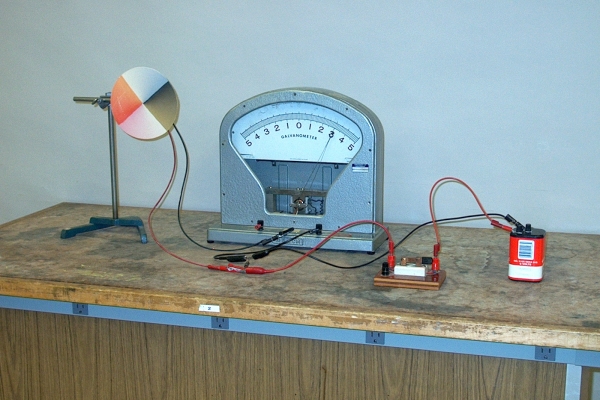

One side of a small, DC permanent magnet motor is connected via a switch to the positive terminal of a battery. The other side is connected to the negative battery terminal via a nichrome wire shunt and a galvanometer. A resistor across the battery and switch provides a path to complete the circuit when you open the switch. The motor turns a cardboard disc whose quadrants are painted different colors, so that the class can see whether or not the motor is turning, and have a rough idea of its speed. The schematic for this demonstration is below:
An overhead transparency of this schematic is available for you to display in class, or you may download a .pdf version here to show on the data projector.
When you first close the switch to apply power to the motor, the galvanometer shows a high reading, which decreases as the motor reaches its maximum speed, at which point the reading remains constant. When you open the switch, the motor, of course, immediately begins to slow down. The galvanometer reading immediately goes negative, then, as the motor slows down and then comes to a stop, rises to zero.
What is happening?
The current flowing through the armature coils in the motor sets up a magnetic field that is not aligned with the field generated by the permanent magnets. This creates a torque that turns the motor and, hence, the paper disc. (See demonstrations 68.48 -- Torque on current-carrying loop, 68.50 -- Permanent magnet DC motor, and 68.51 -- DC motor.) Conversely, the turning of the armature through the magnetic field induces an electromotive force (EMF) in the armature. (See demonstrations 72.03 -- EMF induced by moving magnet, and 72.12 -- AC/DC generator.) Since this EMF is in the opposite direction to the voltage applied to the motor by the battery, it is called a “back EMF.” This back EMF partially cancels the battery voltage, so that when the motor is running, less current flows through it than when it is standing still. The back EMF depends, of course, on the speed of the motor — the change in magnetic flux that generates it increases with motor speed — so that as the motor begins to turn, the back EMF grows until the motor has reached its maximum speed, at which point the back EMF stays at its maximum value. This is why the galvanometer reading starts high, then comes down to a steady value when the motor reaches its maximum speed. When you open the switch, there is no applied voltage, and all that exists across the motor is the back EMF. The galvanometer reading thus goes negative, and it rises as the motor slows down, going to zero when the motor stops.
Back EMF can be critical to the operation of electric motors. If a brownout occurs, the resulting drop in motor speed can reduce the back EMF to the point where the current through the motor becomes great enough to burn it out. Similarly, excessive mechanical loading of a motor can slow it to the point where the loss of back EMF causes damage.